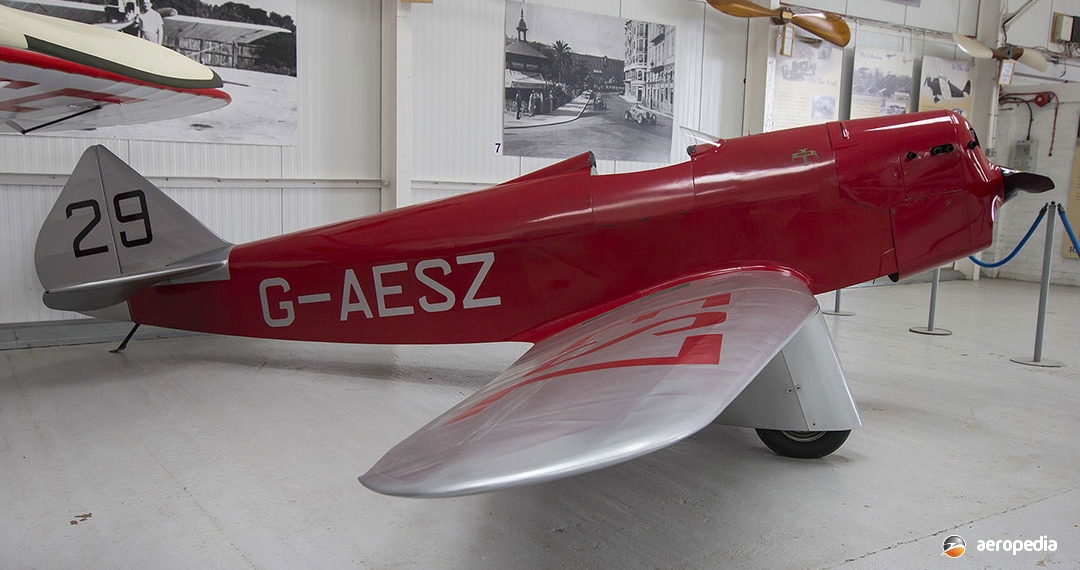Photograph:
Chilton DW-1 G-AESZ (c/n DW-1/1) part of the Shuttleworth Collection of aircraft at Old Warden, United Kingdom in June 2012 (David C Eyre)
Country of origin:
United Kingdom
Description:
Single-seat light homebuilt low-wing monoplane
Power Plant:
One 22 kw (30 hp) Carden-Ford four-cylinder in-line liquid-cooled engine
Specifications:
- Wingspan: 7.31 m (24 ft)
- Length: 5.48 m (18 ft)
- Height: 1.49 m (4 ft 10 in)
- Wing area: 7.15 m² (77 sq ft)
- Max speed: 180 km/h (112 mph)
- Cruising speed: 161 km/h (100 mph)
- Stalling speed: 56 km/h (35 mph)
- Initial rate of climb: 98 m/min (650 ft/min)
- Range: 804 km (500 miles)
- Take-off run: 73 m (240 ft)
- Landing run: 46 m (150 ft)
- Empty weight: 180 kg (398 lb)
- Loaded weight: 290 kg (640 lb)
History:
One of the earliest homebuilts, the DW-1 was designed by Messrs Andrew Dalrymple and A P Ward in 1937 as an easy to build and operate light aircraft with good performance. Initially powered by a 24 kw (32 hp) Carden-Ford liquid-cooled converted motor vehicle engine, the prototype G-AESZ (c/n DW-1/1) first flew in April 1937 and with this engine a maximum speed of 180 km/h (112 mph) was achieved.
In later years a small number were completed with the 41 kw (55 hp) Lycoming O-145-A2 engine; and others had the 34 kw (45 hp) Train 4T, an air-cooled engine manufactured in France. These were known as the DW-1A. The first aircraft with this engine G-AFSV flew in July 1939 and in the Folkestone Trophy Race achieved 203 km/h (126 mph). Eventually G-AFSV was fitted with a 46 kw (62 hp) Walter Mikron 2 engine.
The wings were built in three sections with two spruce box spars, birch plywood, and spruce ribs. It had a Clark YH section. They were plywood covered to the rear spar and the remainder was fabric covered. The ailerons were of wooden framework, the fin and tailplane being plywood covered, and the rudder and elevators were fabric covered. It had split trailing-edge flaps which occupied 50 per cent of the trailing- edge. The Carden-Ford engine was very smooth and was bolted directly to the fuselage. This engine was a conversion of the Ford 10 Model C engine by Sir John Valentine Carden who was the technical director of Vickers Armstrong. It was a four-cylinder, four-stroke unit, and it was used in a number of light aircraft types including the Mignet Pou de Ciel. It weighed with plumbing and radiator 82 kg (180 lb) and gave a power-to-weight ratio of 5.2 lb/hp.
Development continued until the beginning of World War II when a two-seat variant known as the DW-2 was planned but construction of the first of this model was abandoned. Consideration was also given to a racing variant with shortened wings and a retractable undercarriage fitted with the Train 4T engine or a Walter Mikron 2 unit. During the war the Company was involved with war work related and the Chilton Lodge grounds came to be used by the United Kingdom Army Parachute School.
In more recent years interest has been shown in the type and further examples have been or are being built using modern construction techniques and more modern engines to meet new airworthiness regulations. The construction of a DW-1A was commenced in the mid 1990s at Orange, NSW and was nearing completion in late 1997 but is not known to have been completed. A DW-1 fitted with a Rotax engine was completed at Taree, NSW by Australian Aircraft Kits in mid 2020.
An example has been built at Rangiora in New Zealand by Mr Alan Meikle and at least a further four examples are known to be under construction. First aircraft allotted a registration was completed in late 2019, becoming ZK-CHT² to its owner John Gray of Rangiora, powered by a converted Volkswagen (1830 cc) engine.
A number have been airworthy in the United Kingdom, three flying in formation at an aviation event in late 2016, being G-CDXU (c/n PFA 225-12038), G-AESZ (c/n DW-1/1) and G-JUJU (c/n PFA 225-12726).
Late in 2021 an all metal DW-1 fitted with a Rotax 914 engine was completed at Taree, NSW, and became 19-1937.

